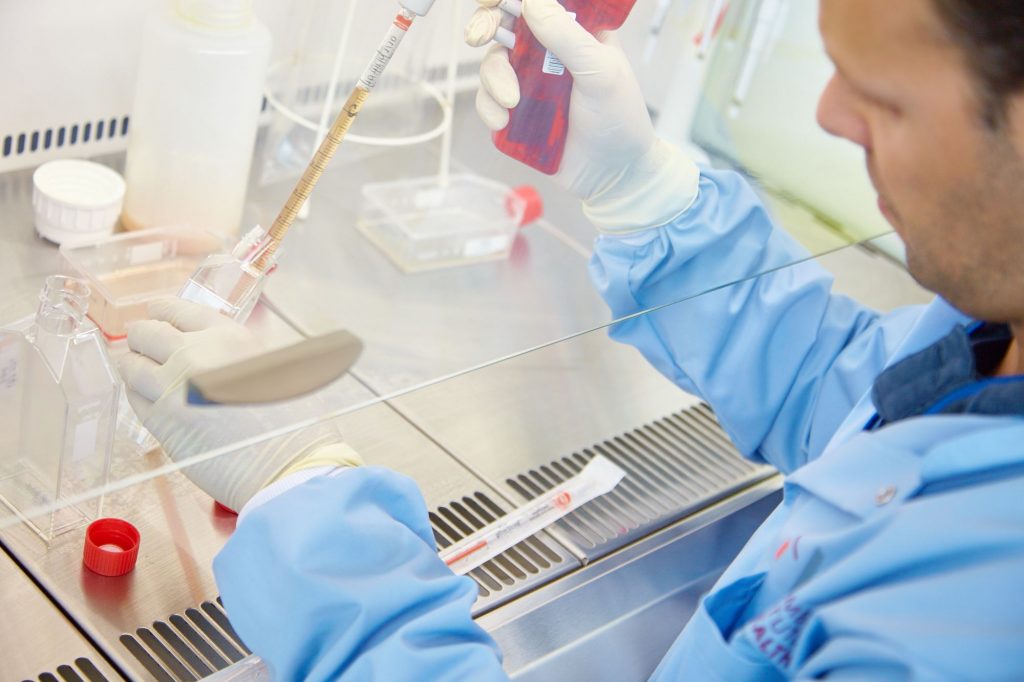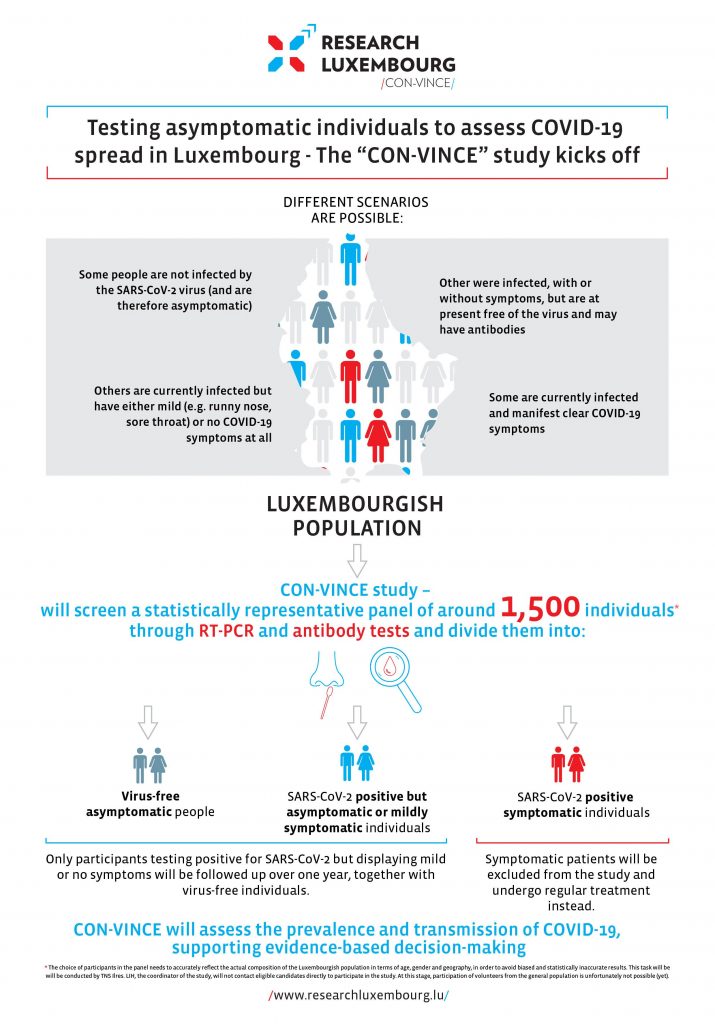Press Release
A deconfinement strategy framed by health and research measures

As part of its exit strategy, the Luxembourg government can count on the support of Luxembourg research, namely the Research Luxembourg COVID-19 Task Force. In close cooperation with the Ministry of Higher Education and Research and the Ministry of Health, the COVID-19 Task Force has developed a “Large Scale Testing Strategy” based on a voluntary diagnostic test accessible to the population, including cross-border commuters of the Greater Region. This will ensure that Luxembourg can better and in an informed manner accompany the lifting of restrictions from the lockdown. The more people participate, the more protection this will mean for the entire population.
“Due to the size of Luxembourg and its limited number of residents, we have a great opportunity: we can test the entire population for the novel coronavirus within a short period of time. This makes us the first country in the world to have a complete overview of the number of infected citizens,” said Minister of Higher Education and Research, Claude Meisch. By shortening the lockdown period, psychological, economic and social problems will be kept to a minimum.
The overall objective is to avoid a second wave of infected people in the context of exit measures and thus the introduction of a new lockdown.
8,500 TESTS FOR STUDENTS AND TEACHERS THIS WEEK, 20,000 TESTS PER DAY IN A LATER PHASE
The testing starts already this week: about 6,000 high school graduates and 2,500 teachers have the opportunity to get tested before they go back to school from May 4th, 2020. They will be informed by letter. The tests are voluntary: everyone can get tested, no one has to.
The testing strategy consists of expanding the capacity to 20,000 tests per day. The objective is to be able to test the entire population, progressively and in contingents, in some cases several times.
BREAKING THE INFECTION CHAIN
“The high number of tests carried out will help to assess the extent of the spread of the virus and to detect for the first time asymptomatic cases, which are currently estimated to account for up to 80% of cases. This means that we can detect many more infected people than before, put them in isolation and track their contacts, thus breaking the infection chain”, says Minister of Health, Paulette Lenert. “As the protection is greater the more people are tested, we want to encourage all residents of the country to participate in this unique public health measure,” she added.
In the next few days and weeks, up to 17 test stations will be set up in the country, where the inhabitants of Luxembourg, but also cross-border commuters, can be tested.
“We are pleased that the government has confidence in Research Luxembourg to support it at this historic stage. The aim is to effectively accompany the spread of the virus and to keep it under control at all times,” says Ulf Nehrbass, spokesman of the COVID-19 Task Force and CEO of the Luxembourg Institute of Health (LIH).
THE CORE ELEMENTS OF THE LARGE-SCALE TESTING STRATEGY
Testing and segmentation of the population into contingents
The Research Luxembourg large-scale testing strategy is based on large-scale virus testing, in which the population is not considered as a whole, but divided into different contingents. The tests per contingent are carried out in 3 stages:
- Stage 1: a representative population of a contingent is tested. The results of these tests give an indication of when the contingent can be freed from restrictions and when it should be tested on a large scale
- Stage 2: All persons in the contingent are invited to be tested on a voluntary basis.
- Stage 3: A representative group is selected shortly after the exit measures in order to be tested a second time. This allows monitoring of whether and how the virus is spreading within the contingent.
For people tested negative, the restrictions of the lockdown are lifted. Positive tested people must enter isolation. Their contacts are traced, tested and quarantined to break the chain of infection.
Projections to better guide the deconfinement strategy
“The projections we make on the basis of the test results help policymakers to make decisions on the exit strategy and to adapt measures to the situation at any time. Important indicators include, for example, the ability to trace contacts and the capacity of the health system”, says Prof. Rudi Balling, Director of the Luxembourg Centre for Systems Biomedicine at the University of Luxembourg.
The COVID-19 Task Force is well organised for this. In collaboration with the Ministry of Health, researchers, statisticians and doctors work together on a daily basis to produce projections for Luxembourg that are as accurate as possible, based on which the decision-makers can then decide on the measures to be taken. This project, which primarily serves a public health objective, will also enable research to gain a better understanding of the virus in the medium term – which is important in order to learn how we can better live with the virus in the future. In addition, the experience gained now will in the long term also serve to be better prepared as a country in the event of another pandemic.
Ease the path towards normality
“What we do here in Luxembourg is unique. Luxembourg can test more extensively than any other country to date. This enables us to take the difficult path out of the COVID-19 crisis towards normality in the most controlled way possible. On the one hand, this minimises risks and on the other hand, provides a solid basis for the government to make decisions,” Ulf Nehrbass concludes.
THE STRATEGY AT A GLANCE
The large-scale testing strategy developed by the COVID-19 Task Force is based on the following 5 elements:
- Consistent monitoring of key parameters – to monitor the evolution of the COVID 19 pandemic in Luxembourg at all times and to provide a basis for decisions on the scope of testing and the introduction of relaxation or restriction measures
- Segmentation of the population into contingents
- High testing capacity: test each contingent, with the aim of gradually and on a voluntary basis testing the largest possible part of the population and then exempting those who test negative from restrictive measures
- Isolation of positive tested people
- Efficient and fast tracing of positive tested people and subsequent quarantine-measures
WHAT IS THE COVID-19 TASK FORCE?
Efficient measures in the context of the COVID-19 pandemic require close cooperation between research, hospitals and the Government in Luxembourg. For this reason, Research Luxembourg (LIH, LISER, LIST, LNS, Luxinnovation, University of Luxembourg and FNR, under the coordination of the Ministry of Higher Education and Research) has set up the COVID-19 Task Force in order to better implement relevant initiatives. Based on a list of priorities elaborated by ministries and other partners, a number of work packages have been defined, which the COVID-19 Task Force will work on in the coming weeks and months. In cooperation with the government, the COVID-19 Task Force sees its role in providing scientific input to enable the government to work on a fact-based EXIT strategy. To this end, the COVID-19 Task Force is continuously working on updates on the development of the pandemic in Luxembourg and submits concepts and recommendations from a scientific perspective so that they can be incorporated into the political decision-making process.
More information: https://researchluxembourg.lu/covid-19-taskforce/
Press release by the Ministry of Health, Ministry of Higher Education and Research and Research Luxembourg









